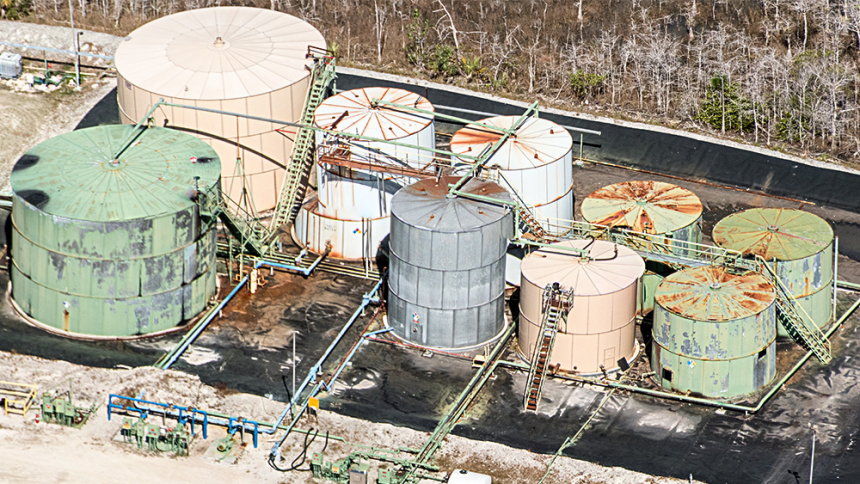This story was originally published by Inside Climate News and is reproduced here as part of the Climate Desk collaboration.
Within a thicket of the Big Cypress National Preserve, established a half-century ago to protect the marshes and sloughs here that make up a vital part of the Florida Everglades, a series of wells extracts oil from more than two miles underground. The oil field is situated deep within a pine forest of the preserve — the first in the country — which channels more than 40 percent of the water flowing into Everglades National Park and shelters iconic and imperiled species like the fabled ghost orchid and Florida panther, the official state animal.
The wells penetrate thousands of feet beneath an underground aquifer, an important drinking water source, and draw up oil from the so-called Sunniland trend, a reserve stretching across southwest Florida from Miami to Fort Myers, although most of the reserve is situated beneath Big Cypress.
For decades, oil production has endured in this corner of the fragile Everglades, a watershed that spans much of the peninsula and is the focus of a $21 billion federal and state restoration effort, one of the most ambitious in human history. Big Cypress is among some 10 percent of federally protected lands nationwide where the government owns the surface terrain while private entities retain the mineral rights underneath.
“Big Cypress National Preserve is very sacred to us,” said Talbert Cypress, elected chairman of the Miccosukee Tribe of Indians of Florida, a federally recognized tribal nation located in the Everglades. “We have a lot of ceremonial grounds that have been in Big Cypress National Preserve, burial grounds, places where we gather our traditional medicine. So just seeing that sort of damage in a place that really matters to us a lot, it’s sad to see it.”
Now the Miccosukee, longtime environmental stewards in Florida who notably helped steer stringent water quality standards for their sacred “river of grass,” have a plan for phasing out oil drilling within Big Cypress. The tribe has joined with WildLandscapes International, a nonprofit land conservation group, to engineer a multimillion-dollar deal with the Collier family, which owns the vast majority of the mineral rights beneath the preserve.
If the agreement is finalized, the family would give up the mineral rights associated with some 465,000 acres to the federal government.
“Unfortunately, I cannot share. It’s under a non-disclosure,” said David Houghton, director of WildLandscapes International, when asked about the details. “The deal includes all the lands that the Colliers own the mineral rights on, minus what they currently have under lease.”
The proposal comes amid interest in expanding oil exploration and development within Big Cypress, even as rising global temperatures associated with fossil fuel emissions represent yet another threat to the Everglades, a watershed responsible for the drinking water of some 9 million Floridians. Most recently a Texas oil and gas company submitted a permit application to the National Park Service for two new sites within the preserve.
“We think we’ve got a deal here. We don’t know that, but we think,” Houghton said. “We’ll get a number, and that number either will work or it won’t — and I think it will.”
Liquid tar
The Everglades are Florida’s most important freshwater resource. The watershed spans central and south Florida, encompassing the Kissimmee River, Lake Okeechobee, sawgrass prairies to the south, and Florida Bay. It includes several federal- and state-protected lands including the Everglades Headwaters National Wildlife Refuge, Florida Panther National Wildlife Refuge, Big Cypress National Preserve, and Everglades National Park.
Various efforts over the last century to drain the Everglades, the largest steered by the U.S. Army Corps of Engineers, have made modern Florida possible and left the river of grass drastically altered.
Inside Climate News
The Humble Oil and Refining Company, a predecessor of Exxon Mobil, discovered oil in Southwest Florida in 1943, after the governor and cabinet at the time offered a $50,000 reward to those who first found oil in the state. Today, Florida is responsible for less than 0.04 percent of the nation’s oil production, according to a report the Conservation Economics Institute, a nonprofit research organization, prepared for the Natural Resources Defense Council. The industry employs fewer than a thousand members of the state’s workforce and accounts for $25.4 million or 0.0002 percent of its gross domestic product.
A separate study by the American Petroleum Institute concluded the oil and natural gas industry contributes nearly $22.1 billion to the Florida economy and supports nearly 266,800 jobs. The vast majority of the state’s oil production occurs in the Panhandle, according to the Conservation Economics report.
The two oil fields within Big Cypress, Bear Island and Raccoon Point, together were responsible for 585 barrels a day in 2020, about one-seventh of the state’s daily total. Oil was discovered at Bear Island, which is located partially within the preserve, in 1972, before the preserve was established, and production began a year later. At Raccoon Point, southeast of Bear Island, oil was detected in 1978. Production began in 1981, and the field was expanded in 1992. Big Cypress was established in 1974.
Two years later, the Collier family, for whom Collier County, where a large portion of the preserve is situated, is named, conveyed 76,790 acres to the National Park Service to help create the preserve, with the family maintaining the underground mineral rights.
The Colliers can trace their family tree to the early 20th century advertising magnate Barron Gift Collier, at the time the largest landowner in Florida. In 1996, the family conveyed an additional 83,000 acres to the National Park Service to expand Big Cypress. Today, Big Cypress encompasses more than 700,000 acres, including much of the western Everglades.
In 2003, the federal government agreed to purchase the Colliers’ mineral rights for $120 million, but the purchase fell through. At the time, various appraisals valued their mineral rights beneath Big Cypress, the Florida Panther National Wildlife Refuge, and Ten Thousand Islands National Wildlife Refuge at between $5 million and $475 million.
The oil here is of the heavy-sour variety, with a consistency of liquid tar, according to a website of the Collier Resources Company, which manages the family’s mineral holdings. When refined, the oil is used in auto, aviation and diesel fuels, lube oils, and asphalt.
Edward Glab, director of the Global Energy Security Forum in the School of International and Public Affairs at Florida International University, characterized the oil as not high-grade or worth a lot of money. Multiple phone calls to the Collier Resources Company were not returned.
“To me it makes no sense drilling for oil anywhere in the Everglades,” Glab said. “It just doesn’t because the reserves are simply not going to be there to justify that sort of investment.”
“It’s a lot of trouble for something that’s not producing a ton of oil, and it’s not like premium-grade oil. It’s like machinery oil, the kind used for heavy machinery,” said Cypress, chairman of the Miccosukee Tribe of Indians of Florida. “For us, when we see the amount of work that goes into the extraction, the damage that they do, it doesn’t seem worth it.”
Acidizing rather than fracking is more likely to be used in Florida to extract oil because of the state’s geology, which is characterized by porous limestone that harbors underground aquifers, according to the Conservation Economics report. Acidizing involves injecting the oil-bearing rock formations with a mixture of acid, water, and other chemicals, dissolving the formations and allowing the oil to flow more easily to the well.
Some 93 percent of the state’s population depends on groundwater for drinking water, far more than any other state in the nation.
Wastewater from such techniques can contain pollutants and threaten the groundwater, although the Collier family says multiple precautions are taken throughout the drilling process to protect the sensitive environment here, according to the Collier Resources Company website. For instance, to safeguard the aquifers, a series of steel casings and thick layer of cement surround all oil-producing wells. At the well sites a limestone pad is constructed with a berm around it to prevent stormwater runoff from carrying pollutants into the environment. The pads also include a…





